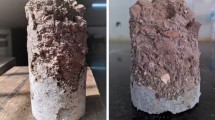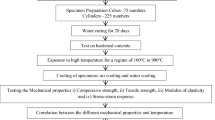Abstract
This paper evaluates the effect of temperatures up to 500 °C on the residual values (i.e. after cooling) of durability-related properties of concrete, namely, the chloride diffusion coefficient and the accelerated carbonation resistance. It is shown that elevated temperatures can be more detrimental to the durability of concrete than to its mechanical performance. Major losses of durability-related performance are found in concrete heated at temperatures considerably lower than the limiting temperature established by design codes and repair guidelines to distinguish sound from fire-damaged concrete. The results obtained in this work suggest that this temperature should be set somewhere between 100 and 200 °C. The UPV test with exponential transducers shows a suitable sensitivity to losses of durability-related performance in thermally-damaged concrete. It is reasoned that, for inspection purposes, UPV tests should be performed on water-saturated specimens with a minimum of four UPV readings taken on both sound and fire-damaged concrete, with a view to detect fire-damaged concrete in single cores drilled from structures.










Similar content being viewed by others
References
Zhou Q, Glasser FP (2001) Thermal stability and decomposition mechanisms of ettringite at <120°C. Cem Concr Res 31:1333–1339. https://doi.org/10.1016/S0008-8846(01)00558-0
Castellote M, Alonso C, Andrade C et al (2004) Composition and microstructural changes of cement pastes upon heating, as studied by neutron diffraction. Cem Concr Res 34:1633–1644. https://doi.org/10.1016/S0008-8846(03)00229-1
Alonso C, Fernandez L (2004) Dehydration and rehydration processes of cement paste exposed to high temperature environments. J Mater Sci 39:3015–3024. https://doi.org/10.1023/B:JMSC.0000025827.65956.18
Ndiaye K, Cyr M, Ginestet S (2017) Durability and stability of an ettringite-based material for thermal energy storage at low temperature. Cem Concr Res 99:106–115. https://doi.org/10.1016/j.cemconres.2017.05.001
Garbev K, Bornefeld M, Beuchle G, Stemmermann P (2008) Cell Dimensions and composition of nanocrystalline calcium silicate hydrate solid solutions. Part 2: X-ray and thermogravimetry study. J Am Ceram Soc 91:3015–3023. https://doi.org/10.1111/j.1551-2916.2008.02601.x
Hewlett P (2004) Lea’s chemistry of cement and concrete, 4th edn. Elsevier, Amsterdam
Taylor H (1997) Cement chemistry, 2nd edn. Thomas Telford Publishing, London
Piasta J, Sawicz Z, Rudzinski L (1984) Changes in the structure of hardened cement paste due to high temperature. Mat Constr 17:291–296. https://doi.org/10.1007/BF02479085
Chan YN, Peng GF, Anson M (1999) Residual strength and pore structure of high-strength concrete and normal strength concrete after exposure to high temperatures. Cem Concr Compos 21:23–27. https://doi.org/10.1016/S0958-9465(98)00034-1
Malhotra HL (1956) The effect of temperature on the compressive strength of concrete. Mag Concr Res 8:85–94. https://doi.org/10.1680/macr.1956.8.23.85
Husem M (2006) The effects of high temperature on compressive and flexural strengths of ordinary and high-performance concrete. Fire Saf J 41:155–163. https://doi.org/10.1016/j.firesaf.2005.12.002
Netinger I, Kesegic I, Guljas I (2011) The effect of high temperatures on the mechanical properties of concrete made with different types of aggregates. Fire Saf J 46:425–430. https://doi.org/10.1016/j.firesaf.2011.07.002
LCPC (2005) Présentation des techniques de diagnostic de l’état d’un béton soumis à un incendie: méthodes d’essai n°62. Paris
Naus DJ (2006) The effect of elevated temperature on concrete materials and structures—a literature review. United States
EN 1992-1-2:2004/A1:2019 (2019) Eurocode 2: Design of concrete structures - Part 1–2: General rules - Structural fire design. CEN
Concrete Society (2008) Technical Report 68. Assessment, design and repair of fire-damaged concrete structures. The Concrete Society, Camberley
dos Santos JR, Branco FA, de Brito J (2002) Assessment of concrete structures subjected to fire—the FBTest. Mag Concr Res 54:203–208. https://doi.org/10.1680/macr.2002.54.3.203
Xu Y, Wong YL, Poon CS, Anson M (2001) Impact of high temperature on PFA concrete. Cem Concr Res 31:1065–1073. https://doi.org/10.1016/S0008-8846(01)00513-0
Gupta T, Siddique S, Sharma RK, Chaudhary S (2017) Effect of elevated temperature and cooling regimes on mechanical and durability properties of concrete containing waste rubber fiber. Constr Build Mater C:35–45. https://doi.org/10.1016/j.conbuildmat.2017.01.065
Wang W, Lu C, Li Y et al (2017) Effects of stress and high temperature on the carbonation resistance of fly ash concrete. Constr Build Mater 138:486–495. https://doi.org/10.1016/j.conbuildmat.2017.02.039
Poon C-S, Azhar S, Anson M, Wong Y-L (2001) Comparison of the strength and durability performance of normal- and high-strength pozzolanic concretes at elevated temperatures. Cem Concr Res 31:1291–1300. https://doi.org/10.1016/S0008-8846(01)00580-4
Felicetti R (2004) Digital camera colorimetry for the assessment of fire damaged concrete. In: Fire design of concrete structures: What now? What next? Politecnico di Milano, pp 211–220
Short NR, Purkiss JA, Guise SE (2001) Assessment of fire damaged concrete using colour image analysis. Constr Build Mater 15:9–15. https://doi.org/10.1016/S0950-0618(00)00065-9
Ingham J (2010) Geomaterials under the microscope: a colour guide. CRC Press, Boca Raton
Concrete Society (2010) Technical Report 71. Concrete petrography. An introductory guide for the non-specialist. The Concrete Society, Camberley
Chew MYL (1993) The assessment of fire damaged concrete. Build Environ 28:97–102. https://doi.org/10.1016/0360-1323(93)90010-Z
Lin Y, Hsiao C, Yang H, Lin Y-F (2011) The effect of post-fire-curing on strength–velocity relationship for nondestructive assessment of fire-damaged concrete strength. Fire Saf J 46:178–185. https://doi.org/10.1016/j.firesaf.2011.01.006
Felicetti R (2006) The drilling resistance test for the assessment of fire damaged concrete. Cem Concr Compos 28:321–329. https://doi.org/10.1016/j.cemconcomp.2006.02.009
fib Bulletin 46 (2008) Fire design of concrete structures - structural behaviour and assessment: State-of-art report. fib
fib Bulletin 34 (2006) Model code for service life design. fib
DuraCrete (2000) General guidelines for durability design and redesign. The European Union - Brite EuRam III Research Project
Beushausen H, Alexander M, Andrade C, et al (2015) Chapter 8 - Application examples of performance-based specification and quality control. In: Performance-based specifications and control of concrete durability: State-of-the-Art Report RILEM TC 230-PSC. Springer
Parrott L (1992) Design for avoiding damage due to carbonation-induced corrosion. Paper no 62-CEN TC 104/WG1/TG1/Panel 1
Chrisp TM, Waldron P, Wood JGM (1993) Development of a non-destructive test to quantify damage in deteriorated concrete. Mag Concr Res 45:247–256. https://doi.org/10.1680/macr.1993.45.165.247
Guo JS, Waldron P (2000) Development of the stiffness damage test (SDT) for characterisation of thermally loaded concrete. Mater Struct 33:483–491. https://doi.org/10.1007/BF02480525
EN 12390-3 (2009) Testing hardened concrete - Part 3: Compressive strength of test specimens. CEN
NT BUILD 492 (1999) Concrete, mortar and cement-based materials: Chloride migration coefficient from non-steady-state migration experiments. NORDTEST
EN 12390-6 (2009) Testing hardened concrete – Part 6: Tensile splitting strength of test specimens. CEN
EN 1504-4 (2004) Testing concrete in structures - Part 4: Determination of ultrasonic pulse velocity. CEN
RILEM TC 56-MHM (1988) CPC-18 Measurement of hardened concrete carbonation depth. Mater Struct 2:453–455
Behnood A, Ghandehari M (2009) Comparison of compressive and splitting tensile strength of high-strength concrete with and without polypropylene fibers heated to high temperatures. Fire Saf J 44:1015–1022. https://doi.org/10.1016/j.firesaf.2009.07.001
Mehta K, Monteiro P (2006) Concrete: microstructure, properties, and materials, 3rd edn. McGraw-Hill, New York
Yim HJ, Kim JH, Park S-J, Kwak H-G (2012) Characterization of thermally damaged concrete using a nonlinear ultrasonic method. Cem Concr Res 11:1438–1446. https://doi.org/10.1016/j.cemconres.2012.08.006
Noumowe AN, Clastres P, Debicki G, Costaz J-L (1996) Transient heating effect on high strength concrete. Nuclear Eng Des 166:99–108. https://doi.org/10.1016/0029-5493(96)01235-6
Li Q, Yuan G, Shu Q (2014) Effects of heating/cooling on recovery of strength and carbonation resistance of fire-damaged concrete. Mag Concr Res 66:925–936. https://doi.org/10.1680/macr.14.00029
Yaman IO, Hearn N, Aktan HM (2002) Active and non-active porosity in concrete Part I: experimental evidence. Mater Struct 35:102. https://doi.org/10.1007/BF02482109
Montgomery DC, Runger GC (2006) Applied statistics and probability for engineers, 4th edn. Wiley, New York
Author information
Authors and Affiliations
Corresponding author
Ethics declarations
Conflict of interest
The authors have no conflicts of interest to declare that are relevant to the content of this article.
Additional information
Publisher's Note
Springer Nature remains neutral with regard to jurisdictional claims in published maps and institutional affiliations.
Rights and permissions
About this article
Cite this article
Valente Monteiro, A., Vieira, M. Effect of elevated temperatures on the residual durability-related performance of concrete. Mater Struct 54, 232 (2021). https://doi.org/10.1617/s11527-021-01824-5
Received:
Accepted:
Published:
DOI: https://doi.org/10.1617/s11527-021-01824-5




